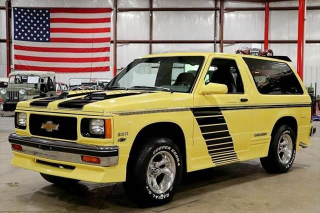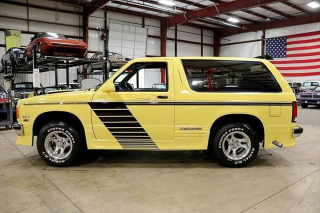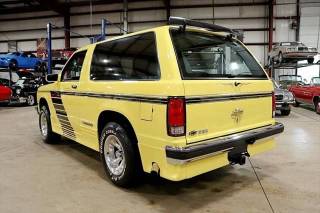The 1987 Chevrolet Blazer, part of the second generation (1973-1991), is a rugged and versatile compact SUV. This model year saw continued refinement of a vehicle known for its off-road prowess and classic American styling. Available in two-door and four-door body styles, key trims often included the base model and the more upscale Silverado. While precise pricing varied greatly depending on condition and options, these vehicles were generally positioned as an accessible yet capable option for adventurers and families alike, offering a blend of utility and everyday drivability that cemented its popularity.
The Good
The 1987 Blazer excels with its robust performance, particularly off-road, and a reputation for solid reliability. Its classic, boxy design evokes a sense of adventure and nostalgia, appealing to emotional buyers. Practically, it offers good utility and a comfortable ride for its class, providing excellent value for those seeking an affordable, capable SUV.
The Bad
Potential owners of the 1987 Chevrolet Blazer should be wary of rust, especially in the body panels and undercarriage. Electrical issues can also arise with age, and the drivetrain, particularly automatic transmissions, may require attention. Fuel economy is not a strong suit for this era's V6 and V8 engines.
1987 Chevrolet Blazer: Quick Overview
- Engine Options: The 1987 Chevrolet Blazer offered a choice of engines, typically including a 4.3L V6 and a 5.0L V8. The 4.3L V6 was a popular choice, known for its torque and durability. The V8 options provided more power for towing and acceleration.
- Horsepower:
- 4.3L V6: Approximately 160-165 horsepower.
- 5.0L V8: Approximately 170-175 horsepower. - Fuel Economy: Fuel economy for the 1987 Blazer was generally modest, reflecting the era and the vehicle's robust construction. Expect figures in the range of 14-17 MPG in city driving and 17-20 MPG on the highway, depending on the engine, transmission, and drivetrain (2WD vs. 4WD).
- 0-60 Times: Acceleration was not the primary focus for the Blazer. 0-60 MPH times typically ranged from 10 to 13 seconds, again varying with engine choice and configuration.
- Towing Capacity: The 1987 Chevrolet Blazer was capable of towing, with capacities generally ranging from 5,000 to 7,000 pounds, depending on the specific configuration, engine, and towing package installed. This made it suitable for light to moderate towing needs.
- Trim-Level Features:
- Base Trim: Typically featured essential amenities, durable interior materials, manual windows and locks, and basic instrumentation.
- Silverado Trim: Offered more upscale features such as upgraded upholstery, power windows and locks, air conditioning, enhanced interior trim, and potentially a better stereo system. Common features across trims included optional four-wheel drive, removable hardtops (on two-door models), and a rugged interior designed for utility.
1987 Chevrolet Blazer Specifications
Vehicle Information
| Year | 1987 |
| Make | Chevrolet |
| Model | Blazer |
| Trim | - |
| Style | 2-Door 2WD 5-Speed Manual |
| Type | Sport Utility Vehicle |
| Category | Minivan Medium Truck |
Manufacturing Details
| Made In | United States |
| Manufacturing City | ST. LOUIS |
Dimensions
| Doors | 2-Door |
| Curb Weight | - |
| Gross Vehicle Weight Rating | - |
| Overall Height | - |
| Overall Length | - |
| Overall Width | - |
| Wheelbase Length | - |
| Standard Seating | - |
Engine & Performance
| Engine | 2.5-L L-4 OHV 8V |
| Engine Size | 2.5L |
| Engine Cylinders | 4 |
| Transmission | 5-Speed Manual |
| Transmission Type | Manual |
| Transmission Speeds | 5-Speed |
| Drivetrain | Rear-Wheel Drive |
Additional Features
| Anti-Brake System | - |
| Steering Type | - |
Pricing
| Manufacturer Suggested Retail Price (MSRP) | - |
| Invoice Price | - |
| Delivery Charges | - |
Vehicle History Report
Vehicle
Specifications
Specifications
Ownership
History
History
All History
Events
Events
NMVTIS Title
History Check
History Check
Salvage/Rebuilt
Check
Check
Accident
Check
Check
Theft
Check
Check
Open Lien
Check
Check
Past Sale
Listings
Listings
Safety
Recalls
Recalls
Odometer
Check
Check
Market Price
Analysis
Analysis
What Problems Does the 1987 Chevrolet Blazer Have?
The 1987 Chevrolet Blazer, like many vehicles of its vintage, has some common issues that owners should be aware of. A primary concern is rust. Due to its construction and age, rust can affect the body panels, particularly the fenders, rocker panels, and the undercarriage. The tailgate and rear quarter panels are also susceptible. Another frequently reported problem area is the electrical system. Over time, wiring harnesses can degrade, leading to issues with lights, accessories, and the engine control unit. Dashboard components, such as gauges and HVAC controls, can also fail. Drivetrain components, especially the automatic transmissions (e.g., the TH700R4), can experience wear and may require rebuilding or replacement if not properly maintained. The transfer case in 4WD models can also develop leaks or mechanical issues. Engine-related problems can include intake manifold gasket leaks, which can lead to coolant loss and overheating. Carburetor issues may also arise on some models. While specific model year recalls for 1987 are not extensively documented for major widespread defects, routine maintenance and addressing minor issues proactively are key to long-term reliability. The overall reputation for the second-generation K5 Blazer is one of robustness, but age-related wear and tear are inevitable. Owners who prioritize regular fluid changes, inspect for rust, and address any nascent electrical or mechanical gremlins promptly tend to have the most reliable experiences. Some specific mechanical components like the power steering pump and starter motor can also be points of failure over time.
How long will the 1987 Chevrolet Blazer last?
Based on owner data and typical maintenance habits, a well-maintained 1987 Chevrolet Blazer can realistically achieve 200,000 to 250,000 miles, and in some cases, even more. The long-term durability of these vehicles is generally good, thanks to their robust construction and often simpler mechanical designs compared to modern SUVs. However, weaknesses emerge over time, primarily related to rust, which can compromise the structural integrity if left unaddressed. Age-related electrical issues and wear on drivetrain components (engine, transmission, axles) are also common. With diligent upkeep, including regular fluid changes, addressing rust proactively, and tending to minor mechanical concerns, the Blazer demonstrates remarkable longevity, proving itself a durable companion for many years.
What Technology & Safety Features are Included?
The 1987 Chevrolet Blazer, reflecting its era, offers a relatively basic suite of technology and safety features. Built-in tech was primarily focused on functionality rather than luxury or advanced connectivity. Standard entertainment options typically included an AM/FM radio, with optional upgrades like a cassette player or a premium sound system available on higher trims. Air conditioning was often an optional feature. There were no advanced driver-assistance systems in the modern sense; features like power windows and locks were considered modern conveniences and were often optional. Safety features were also standard for the time. This included seatbelts (lap and shoulder belts in the front), and for 1987, anti-lock brakes (ABS) became available on rear-wheel-drive models, offering a significant improvement in braking control, especially during emergency stops. Optional on some models was a limited-slip differential for improved traction. Crash-test ratings for vehicles of this vintage are not readily available through modern standardized testing protocols like those conducted by the NHTSA or IIHS today. However, the Blazer was built with a strong, body-on-frame construction, which offered a degree of inherent structural integrity. Its solid build contributed to its reputation for durability. The removable hardtop on two-door models, while adding to its iconic appeal, could potentially compromise structural rigidity in a rollover scenario compared to a fixed-roof vehicle. Overall, the 1987 Blazer prioritized mechanical robustness and essential amenities over sophisticated electronic systems or advanced safety technologies.
What Colors Options are Available?
1987 Chevrolet Blazer Prices and Market Value
When new in 1987, the Chevrolet Blazer had a starting MSRP that generally ranged from $14,000 to $18,000, with higher trims and optional features pushing the price upwards. Today, the used market for a 1987 Blazer varies significantly. Excellent, low-mileage examples can fetch anywhere from $10,000 to $25,000+, especially highly sought-after trims or well-restored models. More common, driver-quality examples typically range from $4,000 to $9,000. Depreciation was significant in the initial years, as is typical for most vehicles. However, the Blazer has since found a strong following, and its resale value has stabilized and even increased for well-preserved examples. Factors affecting resale value include overall condition (rust is a major detractor), mileage, originality, maintenance history, and the presence of desirable options like 4WD or V8 engines. Restored or highly original Blazers are particularly valued by enthusiasts.
1987 Chevrolet Blazer Cost of Ownership
Owning a 1987 Chevrolet Blazer can be moderately costly, especially considering its age. Insurance rates are generally reasonable for classic or older vehicles, but comprehensive coverage will depend on value. Fuel costs are a significant factor, with V6 and V8 engines offering less-than-stellar MPG. Routine maintenance is manageable, with many parts being readily available and affordable for a vehicle of this era. However, unexpected repairs, particularly for aging electrical systems, transmissions, or rust remediation, can add up. While not economical in terms of fuel, its mechanical simplicity can make repairs less expensive than more complex modern vehicles. Long-term ownership costs are moderate, requiring a commitment to upkeep rather than being an outright expensive vehicle.
1987 Chevrolet Blazer Fuel Efficiency
Fuel Type
Gasoline
Fuel Capacity
-
City Mileage
-
Highway Mileage
-
1987 Chevrolet Blazer Warranty
Basic
Original warranty
0 months / No data
Estimated remaining
Expired
Powertrain
Original warranty
0 months / No data
Estimated remaining
Expired
Rust
Original warranty
0 months / No data
Estimated remaining
Expired
1987 Chevrolet Blazer Insurance
Insurance for a 1987 Chevrolet Blazer is moderately priced, reflecting its status as a Sport Utility Vehicle with strong safety ratings and
reasonable repair costs.
reasonable repair costs.
How Does the 1987 Chevrolet Blazer Compare to Other Sport Utility Vehicle?
In its class, the 1987 Chevrolet Blazer competed with vehicles like the Ford Bronco, Dodge Ramcharger, and Jeep Cherokee (XJ). In terms of raw off-road performance, the Blazer, especially with 4WD, was highly capable, often matching or exceeding the capabilities of its rivals. Its robust construction and available V8 engines gave it a performance edge in towing and power over some competitors. Feature-wise, the Blazer offered a blend of utility and comfort, with higher trims providing amenities competitive with the Bronco and Ramcharger, while the Jeep Cherokee (XJ) often provided a more refined and modern interior for its time. Reliability is a mixed bag; while the Blazer's powertrains are generally robust, age-related issues like rust and electrical problems are common across all these vehicles. The Jeep Cherokee (XJ) is often lauded for its unibody construction and legendary reliability, making it a strong alternative for those prioritizing longevity and a smoother ride. The Ford Bronco, particularly later models, offered comparable ruggedness. In terms of price, the 1987 Blazer was typically competitively priced against its peers. For similar rugged capability, the Jeep Wrangler YJ is another consideration, though often with less interior space and comfort. If a more modern, integrated design with better on-road manners and fuel efficiency is desired, contemporary SUVs like the Toyota 4Runner or Nissan Pathfinder (early models) could be considered, though they might offer less raw V8 power and towing capacity than the Blazer. For a classic, body-on-frame SUV experience, the Blazer remains a compelling choice, but the Jeep Cherokee (XJ) often edges it out in overall long-term ownership satisfaction due to fewer rust issues and a more modern feel.
Final Verdict: Is the 1987 Chevrolet Blazer a Good Sport Utility Vehicle?
The 1987 Chevrolet Blazer is ideal for enthusiasts who appreciate classic American SUVs, off-road adventurers, and those seeking a rugged vehicle for light towing or utility. It is worth buying for individuals who value its iconic styling, robust off-road capability, and the potential for a rewarding ownership experience, provided they are prepared for potential maintenance. It's best purchased as a used vehicle, as new models are unavailable. Buyers should prioritize examples with minimal rust, a well-documented maintenance history, and preferably those with the 4.3L V6 or a V8 engine. Higher trims like the Silverado offer more comfort. It's a good buy for those who enjoy tinkering and understand the needs of an older vehicle, rather than expecting modern reliability without effort.



